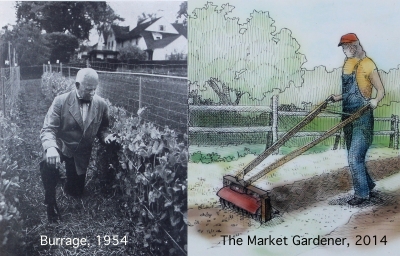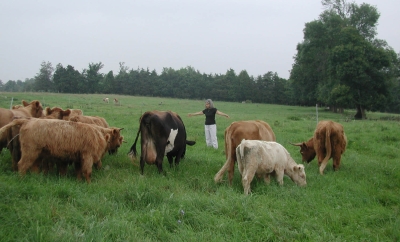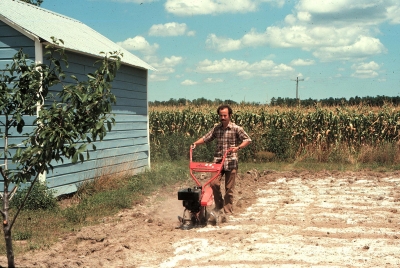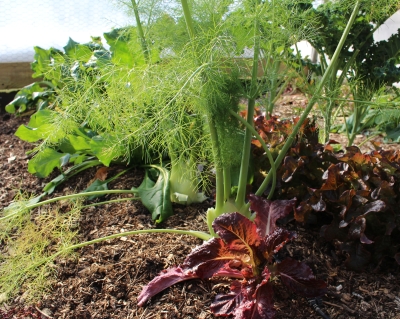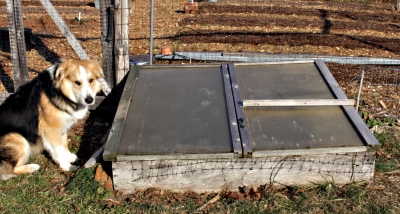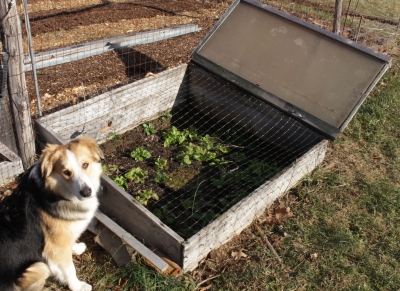GOOD BOOKS, GOOD LECTURES
/3 Comments/in Books, Design, Gardening, Planning, Tools, Vegetables/by Lee ReichOne Book = Years of Experience
I’ve been gardening for over 30 years. Don’t be impressed. The number of years spent with hands in the dirt doesn’t necessarily confer any particular expertise in the field (pun intended). Some gardeners do the same foolish things year in and year out, or never sufficiently investigate other, perhaps better, ways of doing what they’ve been doing. Or not appreciate cause and effect. (Was it really the compost tea spray that led to bountiful yields last year, or was it reliable rainfall interspersed with bright, sunny days? The tendency is to hold the former responsible.) Or, the wizened, old gardener’s wealth of knowledge might not extend beyond what they’ve grown on their own “back forty,” severely limiting the benefit of any wisdom passed on to others with a shorter history of gardening.
Reading is a efficient way to squeeze wisdom of others, reflecting decades of digging, pruning, and seed-sowing, into just a few years, for yourself — depending, of course, on the weight of the words. The fact that so many gardeners have always gotten by with little or no reading is testimonial to millions of years of evolution that makes every pea seed naturally want to grow and every apple tree naturally want to bear fruit.
So, in the spirit of becoming better gardeners, especially this time of year with nothing to do in the garden, let’s thumb through the pages of three worthy books that recently found a place on my desk.
Good Tools are a Help
Did you know that the hose was invented by Jan van der Heijden in the 17th century? Tarred canvass, linen, and hand-stitched lengths of leather pipe were all predecessors of the modern garden hose, all of which I learned from Bill Laws’ A History of the Garden in Fifty Tools. It wasn’t until near the end of the 19th century that technology and marketing brought hoses into more general use in gardens.
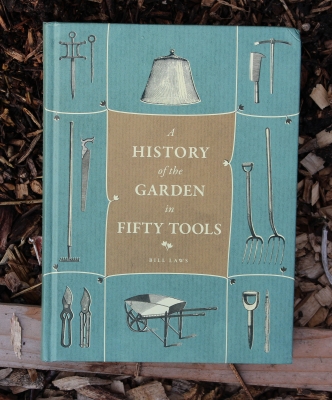 Just imagine having to water your garden with repeated trips to the spigot with your watering can, another of Mr. Laws’ “Fifty Tools.” Not that the garden hose has displaced watering cans, which have been around in various incarnations for hundreds of years and may have reached their peak in functional and visual elegance with the work of John and Arthur Haws. Haws cans are still made; my 2 gallon, galvanized Haws watering cans have served me and my plants well for over 20 years.
Just imagine having to water your garden with repeated trips to the spigot with your watering can, another of Mr. Laws’ “Fifty Tools.” Not that the garden hose has displaced watering cans, which have been around in various incarnations for hundreds of years and may have reached their peak in functional and visual elegance with the work of John and Arthur Haws. Haws cans are still made; my 2 gallon, galvanized Haws watering cans have served me and my plants well for over 20 years.
. . . Fifty Tools will not, admittedly, make anyone a better gardener. Instead, it’s a very interesting history of 50 gardening tools with — okay, this might be some help in the garden — sidebars, “Tools in Action,” telling of the best use of each tool.
Some listing are a stretch of the word “tool:” a radio, a scarecrow, separate entries for plant container, terracotta pot, and stoneware urn? I would have included the garden cart, pitchfork, and hori-hori knife as necessary garden accoutrements.
Inspiration from Paris
In and Out of Paris: Gardens of Secret Delight by Zahid Sardar, with photographs by Marion Brenner is slightly more practical than A History of the Garden in Fifty Tools, even if I’m not planning to garden in Paris or like a king. The first section, eye candy, has the usual gardens of a literally majestic scale: Versailles, the Tuileries, Vaux-le-Vicomte, etc.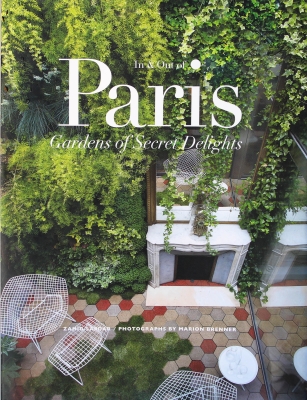 Sections on private gardens are more inspirational for us non-royalty. Most of the gardens, whether majestic or small, are typically French, with long views or symmetric arrangements. Not one of the gardens, though, the 1000 square foot Japanese garden near the Bastille, with carefully placed, but not seemingly so, boulders nestled into mosses, lichen bordering a koi pond. Walls shield the garden from the sight and sound of the surrounding city, the effect softened with clumps of bamboo and a mix of evergreen and deciduous trees.
Sections on private gardens are more inspirational for us non-royalty. Most of the gardens, whether majestic or small, are typically French, with long views or symmetric arrangements. Not one of the gardens, though, the 1000 square foot Japanese garden near the Bastille, with carefully placed, but not seemingly so, boulders nestled into mosses, lichen bordering a koi pond. Walls shield the garden from the sight and sound of the surrounding city, the effect softened with clumps of bamboo and a mix of evergreen and deciduous trees.
One of the most interesting gardens is the Experimental Parc Méry-sur-Oise, which started life as the historic Renaissance-era Chateau de Méry-sur-Oise. More recently, in 1999, the grounds were re-done, this time with water features, not  traditional fountains, but misty, hot, cold, brackish, and mineralized water that rains down from above or tumbles over waterfalls. Long-term goals, the “Experimental” part of the garden, include observations of the effects of the various waters on plants and the ecosystem over time. Elsewhere are free-standing gabion walls planned for vertical gardens. That never happened. Money ran out and the gardens have been neglected since 2003 — a modern, neglected garden!
traditional fountains, but misty, hot, cold, brackish, and mineralized water that rains down from above or tumbles over waterfalls. Long-term goals, the “Experimental” part of the garden, include observations of the effects of the various waters on plants and the ecosystem over time. Elsewhere are free-standing gabion walls planned for vertical gardens. That never happened. Money ran out and the gardens have been neglected since 2003 — a modern, neglected garden!
In all honesty, I mostly just looked at the beautiful photographs of In and Out of Paris: Gardens of Secret Delight.
Grow Vegetables? Study this Book
Even if you are a backyard gardener rather than a market gardener, The Market Gardener, by Jean-Martin Fortier, will have you harvesting more and better tomatoes, and with less effort. Two themes of this book, as I see it, are planning and record-keeping. The author is a successful market gardener in Quebec, grossing over $100,000 from a mere acre and a half of land.
The growing units on Jean-Martin’s farm are raised beds 100 feet long by 30 inches wide. Having all beds the same makes it easy for him to calculate the amount of compost needed and keep track of yields. The latter are spelled out in a handy chart showing days to maturity and yield of individual vegetables per 100 foot bed. I haven’t calculated yields from my 17 foot by 36 inch wide beds, but do know that I need to plant 4 beds at two week intervals to harvest our fill of sweet corn to enjoy during summer and, frozen, through winter.
Another useful table spells out spacing of transplants, in flats and in beds, and another lists dollars reaped per bed from various vegetables. The only other gardening book that quantifies small-scale vegetable growing so well, in this case strictly backyard growing, is Burrage on Vegetables, from 1954, by Albert Burrage. How times have changed: Burrage is pictured in his garden in sport coat and bow tie; farmers in Jean-Martin’s book are pictured dressed as, well, farmers.
The book also has the requisite listing of each vegetable along with growing information as well as useful chapters on soil care (generally good but with some misconceptions) and microclimate. One particularly simple, cheap yet innovative technique described for weed control after harvest, between plantings, is covering a bed for 2 weeks with a reusable 6mm thick, black silage tarp.
Jean-Martin emphasizes that it is possible for farming and gardening to be, at the same time, productive and bucolic only with planning and organization to avoid wasting time. In so doing, he can be a farmer who can put in a workday from a reasonable 8 to 5. Charles Dudley Warner wrote in his 1870 classic My Summer in the Garden, “Blessed be agriculture! If one does not have too much of it.” I agree.
Talks in Pennsylvania & Vermont Coming Up
Some good conferences and lectures coming up. I’ll be in Pennsylvania and Vermont talking about espalier fruits, weedless(!) gardening, growing hardy kiwifruit, pawpaws, and blueberries, the efficacy of compost tea, and pruning fruits. For details, see my “Lectures” page.
NOTHING TO DO? SEQUESTER CARBON?
/2 Comments/in Gardening, Planning, Soil/by Lee ReichAgriculture: Good or Bad for Our Planet?
I’m enjoying this farmdening interlude, with essentially nothing to do, farmdenwise, for a few weeks. No planting, no pruning, no weeding. Seeds have been ordered and the greenhouse, full of lettuce and kale and chard and other fresh stuff, is cold enough to require no more than weekly waterings, if that. Even then, watering involves nothing more than a quarter turn of the mechanical timer to start water running through the drip irrigation lines.
I’m going to use this lull as an opportunity to ruminate — on rumens and other relationships between agriculture and global warming.
Let’s get started right away with the rumen, that part of the digestive system of a cow, steer, or other ruminant where cellulose is fermented. With a capacity of more than 50 gallons, a cow’s rumen is a veritable factory, one whose byproduct is a lot of gas, more than 200 gallons a day, belched out by the cow. No small thing, that collective burp of agricultural ruminants. It’s good for the cow (when you consider the alternative) but not so good for the environment. A significant portion of the effluvia is methane, a carbon compound which is 20 times more heat-trapping in the atmosphere than carbon dioxide.
Let’s leave the cows alone and drop down to the soil. Global warming from the agricultural soils? Yes. Harvest a crop, any crop, and you’re removing nutrients from the site. So those nutrients need to be replaced, and that’s usually done with fertilizer. Fertilizer, unlike money, does, or can, grow on trees (such as honeylocust and others in the pea family, which garner nitrogen from the air a put it in the soil) but most fertilizer is synthetic. Synthetic fertilizer must be cobbled together using energy derived from fossil fuels, which then release carbon dioxide into the atmosphere.
That’s not all. The soil itself is a large reservoir of carbon tied up in complex, organic compounds as well as in living and dead organisms. Stir that soil up with a plow, a tiller, or a garden fork, and you charge it with oxygen, just what bacteria, fungi, and other microorganisms are waiting for so that they can gobble up that carbon, grow and extract energy, then release carbon dioxide to the atmosphere.
Of Tillage and Biochar
“Sequestration” isn’t only something done with our money by a bunch of mostly men in a big room (Congress) in Washington. It’s also done by farmers to save, not money, but carbon. The idea is to keep carbon in the soil rather than letting it “burn” to carbon dioxide, waft into the atmosphere, and contribute to global warming.
Minimizing, or eliminating, tillage is one way to sequester carbon, something that can be done on a home or small farm scale, even on a large scale. I haven’t tilled my garden in over 20 years, and 22 percent of Midwestern farmland is no-till. Minimal tillage or no-till also brings other benefits, such as reduced weeds, a friendlier environment for earthworms and fungi, more efficient plant water use, more organic carbon in the soil for livelier biological activity and improved soil aeration, and, of course, the benefit of not having to till.
Biochar is another proposed savior in these carbon-burning times. Biochar is, basically, charcoal, which is mixed into the soil. Charcoal starts out as wood which, when left in or on the ground, rots, the carbon within turning to carbon dioxide. Charring the wood drives off much of what makes up wood, leaving only black carbon, a poor food for soil microorganisms, so it does not rot. The wood’s carbon has been locked up, sequestered, changed from organic carbon to inorganic, or elemental, carbon.
Hold that Carbon, But Not Too Tightly
When it comes to agriculture, keeping too tight a grasp on carbon is not a good thing. Agriculture, whether farming or gardening, isn’t Nature, or else my garden and yours would be all weeds (some of which would be edible and, hence, technically not “weeds”).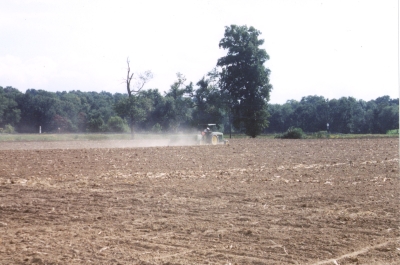
Carbon is energy, fueling growth of fungi, earthworms, and other creatures, and as it’s “burned,” nutrients associated with it are released into the soil in forms that plants can use. That’s a good thing, to a degree. Fermentation microorganisms within cattle rumen make cellulose available for energy and growth even as they release methane. That’s also a good thing, to a degree.
Good gardeners and farmers strike a congenial balance, emulating Nature without giving her a free hand. Too many cows belching methane is not good for the planet. Too much tillage “burning” up soil organic matter and releasing carbon dioxide also is not a good thing.
———————————————————
A final word, about radishes, for no reason except that I am enjoying them right now. Winter radishes are large, variable in shape and color, and store well. Today, as I’ve done every few days since late fall, I sink my hand into a cold, wooden box full of wood shavings to pull out yet another Watermelon radish. Sliced open, this variety of winter radish looks much like watermelon and tastes — no, not like watermelon — but crisp, sharp, and slightly sweet. Highly recommended; sow seeds July 15th.
FRESH-PICKED SALADS ALL WINTER
/7 Comments/in Gardening, Vegetables/by Lee ReichGreenhouse, Coldframe, Hotbed = Fresh Lettuce, Mâche, & other Salad Fixings
You can’t beat the luxuriousness of entering a greenhouse on a sunny, cold winter day, and hitting that welcome wall of moist, warm air. Once you get through that soft wall, you drink in the redolence and visual vibrancy of green, growing plants. All this is possible even with a relatively inexpensive greenhouse, such as mine, which is, basically, 2 layers of plastic film supported by sturdy, steel hoops (plus thermostats, a propane heater, a cooling fan, and a “squirrel cage” fan to inflate the space between the layers of plastic for better insulating value).
Still, a greenhouse — my greenhouse, at least — isn’t for virtual trips to Puerto Rico; It’s for growing edible plants, mostly fresh lettuce, celery, mâche, claytonia, and arugula to fill the salad bowl every day from late fall through early spring.
This same benefit, though, can almost be achieved much more simply and much more cheaply with a coldframe. A coldframe, in its most basic incarnation, is a box frame covered with glass or some other transparent material and within which plants are grown or protected through the coldest months.
I have both a greenhouse and a coldframe. The coldframe came first. With a greenhouse full of greenery, I admit to usually neglecting the coldframe, which is unheated and only 25 square feet in contrast to the greenhouse’s heated 750 square feet. Still, last fall I had an extra 25 lettuce transplants and lacked even a square foot of extra space in which to plant them in the greenhouse. So I spread an inch of compost in the coldframe, firmed the transplants into holes there, and then gave the whole bed a good watering before replacing the cover.
Except for one subsequent watering, I’ve pretty much ignored the coldframe. The polycarbonate (‘Exolite’) cover is translucent so the coldframe’s innards are hidden from view unless the cover is lifted. Today, mostly out of curiosity, I lifted the cover to see what was going on inside. The lettuce was alive and had grown. Fall weather was admittedly relatively mild although temperatures here did drop below 10°F at least one night — pretty good survival for plants growing in little more than a covered box outdoors.
With short days and cold weather, lettuce is growing very slowly. Individual leaves, perhaps whole heads, probably will not ready for harvest until towards the end of February. That’s if the lettuce survives that long, which it might not even in the coldframe, depending on the length and depth of winter cold. Spinach would more likely make it through winter; mâche and claytonia would definitely weather the coldest days and nights.
Beefing Up the Coldframe
In the absence of a greenhouse, I would beef up coldframe salad production to yield more and for more of the winter. I would, first of all, construct more coldframes because, with slow growth inside in winter, one harvest could decimate the crop, for a period at least, from just one coldframe.
Anything that helps the coldframe fend off cold and retain heat would also help increase the amount and duration of harvest. Insulating the sides helps, and said insulation need be nothing more than wood chips or straw piled up against the sides. Or make the box itself out of whole bales of straw!
Heat rises and glass and plastic are poor insulators, so most of the heat is lost through the translucent or clear covering. The Exolite cover on my coldframe is actually 2 layers of polycarbonate plastic sandwiching polycarbonate ribs that hold the layers 1/4” apart, proving better insulating value than a single layer. On really cold nights, an insulating mat, even just a blanket could be thrown over the cover. In Europe a hundred years ago, cold frames were used extensively for commercial vegetable production, and mats of woven straw covered the glass to keep out the coldest weather.
A few feet down into the earth, temperatures remain constantly in the 50s. That earth is a source of heat, tapped into by sinking the floor of the coldframe a couple of feet deeper, which also allows head space for taller vegetables, such as Romaine lettuce. Too deep, of course, makes harvesting very inconvenient.
And finally, winter production can be beefed up by actually heating a coldframe, in which case it’s no longer a “coldframe” but what’s called a “hotbed.” The traditional heat source for a hotbed is horse manure, layered into the bottom of the bed after a foot or so of soil has been dug out. A certain art is involved in getting the right amount and moisture content of manure, packed in just right and then covered with soil for a steady even heat. I made my coldframe into a hot bed a couple of years ago, or, rather, tried to. I didn’t get it just right; will have to try again.
True, you can’t climb into a coldframe for a tropical junket, but the coldframe, with care, can become a hotbed of tasty, fresh, organic, very locally-grown vegetables from fall to spring.


